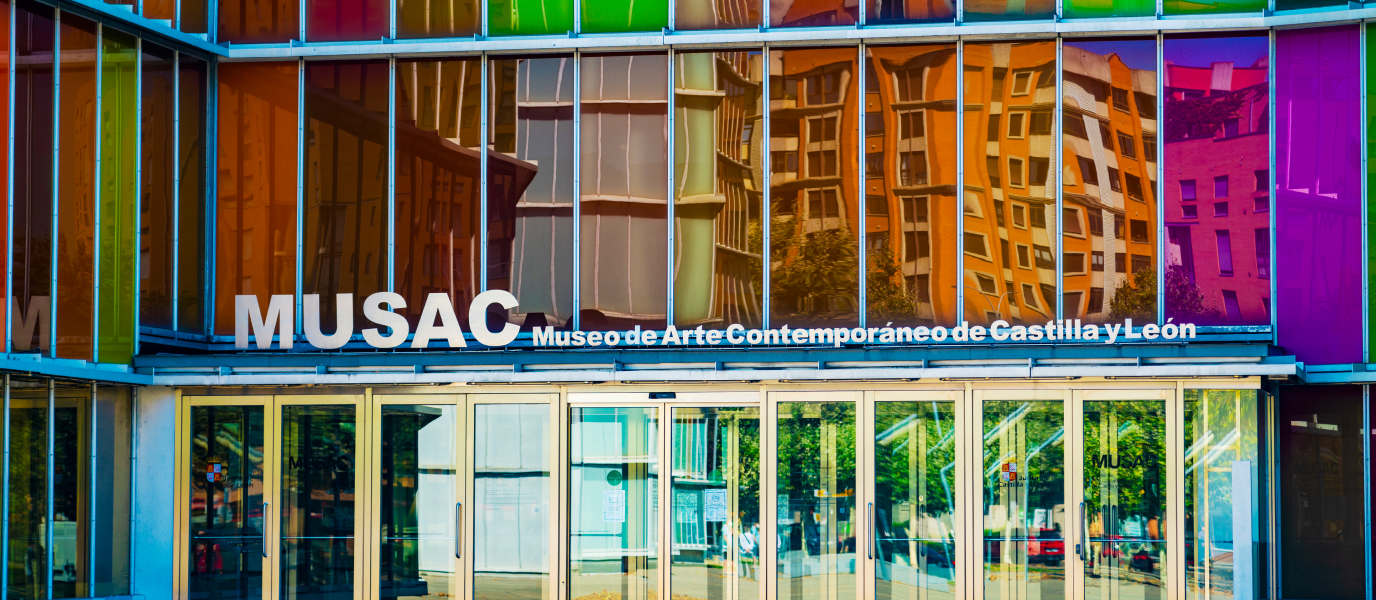If there is one thing that characterises León, it is its constant encounter with history, that of Spain and that of the kingdom of León itself. It has areas from the Romanesque period, Gothic cathedrals, imposing Renaissance buildings and even examples of the best Spanish modernism. Nevertheless, it does not want to stay in the past and looks directly at the future thanks to the Museum of Contemporary Art of Castilla and León (MUSAC).
In fact, this museum is one of the most advanced centres for current artistic trends in Europe.
It began by focusing solely on artistic developments dating after 1992 but, after several changes of direction and perspective, it now houses works dating after the 1960s.
With such ingredients, entering the MUSAC gives visitors the master key to opening their senses to thousands of stimuli, enabling them to be surprised, invaded and encouraged by such different artistic proposals.
Just getting to the doors of the museum is also worthwhile, as the MUSAC is housed in a spectacular building, which was awarded the European Union Prize for Contemporary Architecture – Mies van der Rohe Award – in 2007.
History and context of the MUSAC
The MUSAC (Museum of Contemporary Art of Castilla and León) was inaugurated on 1 April 2005 as a public regional entity. From the outset, its aspiration has been to become the largest contemporary art centre in the Castile and Leon region. Nevertheless, its commitment to innovation has made it one of the most advanced in Europe.
In its first three years, under the direction of Rafael Doctor Roncero, it was decided that no works at the MUSAC could predate 1992. The idea was to have a museum of the present.
The date chosen was not trivial, as 1992 was a key year for Spain: it marked a turning point thanks to the Seville Expo and the Barcelona Olympic Games.
In 2009, the museum’s direction changed under Agustín Pérez Rubio. In his four years, Pérez Rubio was committed to creating a social platform for community action and thinking. At that time, the museum began to include works dating after 1989, another legendary date for Europe due to the fall of the Berlin Wall, an event that marked a milestone in the development of new artistic trends.
In mid-2013, Manuel Olveira took over as director, and he is still in office today. He thought that the best thing to do was to turn the MUSAC into an open space for knowledge and from there it began to exhibit works created after the 1960s.
Things to see at the MUSAC
The MUSAC collection in León has 1,144 works by 426 artists, reflecting practically all the current practices and trends. It is one of the major collections of post-1960s art in Spain and one of the best in Europe.
In the various exhibitions, you will find local and regional artists since the MUSAC seeks a balance between the local and the global. All you need to do is explore it with your senses wide open and your mind almost blank to soak up the latest trends.
One of the museum’s most striking aspects is that its collections are not always shown inside the halls, but rather some works are shown outside its walls in what is called the MUSAC OFF.
The building’s architecture
The building housing the MUSAC is in itself a work of art. It was designed by two Spanish architects, Emilio Tuñón and Luis Moreno Mansilla, who received the Spanish National Architecture Award in 2003.
Their idea was to create for the MUSAC a large cultural area connected to the history of Léon where future and past would be united once again in the largest regional art exhibition.
As a result, the white concrete building has a geometric ground plan, reminiscent of certain Roman pavements, and is completed with stained glass windows inspired by the city’s most famous mosaic, the 13th century ‘Falconers’ mosaic in the cathedral.
In total, there are 3,351 glass panes (of which 2,719 are translucent) on 500 prefabricated concrete beams, which reconstruct the stained glass window in 37 colours thanks to image digitalisation, which amazes all the visitors.
Planning your visit
There are several types of visits to the MUSAC that can be made on a scheduled basis, apart from touring the exhibition halls on your own. Every Sunday, it organises a guided tour with supplementary activities and there are also exhibitions on specific topics.
Moreover, the MUSAC is not only for adults. Knowing that art is a dream that everyone can enjoy, the museum organises family visits adapted for children over five.
Another way of exploring the MUSAC is with a simultaneous guide in spoken and sign language so that people with and without hearing disabilities can share this artistic journey.
Where to stay in the centre of León
The best way to enjoy the MUSAC is to stroll through the historic centre to reach the façade of the impressive building that houses it. Two key accommodation options are the four-star Barceló León Conde Luna, with two of the city’s best restaurants, Nimú Azotea and Casa Mando; and the Occidental León Alfonso V, also four-star and perfectly located to enjoy León’s oldest and newest parts at a glance.












































































